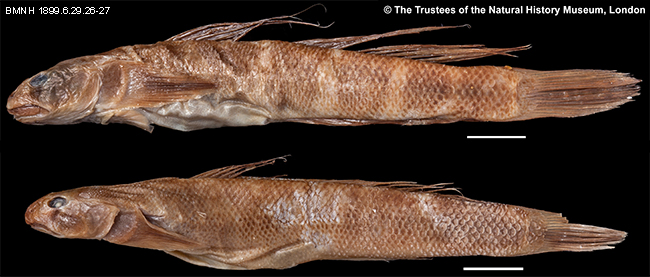Gobidae - Sicydium rosenbergii (Boulenger, 1899) |
 |
| Syntype specimens from British Museum of Natural History courtesy of James Maclaine and Kevin Webb. |
| SOURCE FOR OCCURRENCE IN ECUADOR: Boulenger (1899), Barriga (2012), Jimenez et al. (2016). |
| ORIGINAL DESCRIPTION: Boulenger, G.A. 1899. Description of a new genus of gobioid fishes from the Andes of Ecuador. Annals and Magazine of Natural History (Series 7) v. 4 (no. 20) (art. 12): 125-126. |
| TYPE SPECIMENS: |
| TAXONOMIC STATUS: Valid (Eschmeyer and Fricke, 2016). |
| RANGE ECUADOR: Type locality is described as Paramba at 3500 feet (1066.8 m) above sea level in northwestern Ecuador (Boulenger, 1899). Listed as occurring in the Santiago-Cayapas and Esmeraldas drainage systems (Barriga, 2012; Jimenez et al., 2016). Aguirre et al. (2017) recently reported collections from southwestern Ecuador including the Jubones and Santa Rosa rivers in El Oro province (close to Peru), although the identification to species was only tentative and needs to be confirmed. |
| RANGE OUTSIDE OF ECUADOR: Historically, this species has been considered endemic to Ecuador, however, a specimen collected in the Chancay River in northwestern Peru has recently been reported suggesting that S. rosenbergii may also occur in Peru (ROM 91180; reported in Aguirre et al., 2017). This record needs to be confirmed. |
| COLLECTIONS IN ECUADOR: |
| MAXIMUM SIZE: 113 mm total length based on two specimens in species description (Boulenger, 1899). Fishbase (2016) lists a maximum size of 11 cm TL as well. Probably grows to larger sizes. |
| DISTINGUISHING FEATURES: Boulenger (1899) provides the following distinguishing features for this species. Depth of body six times in total length, length of head 5-5.5 times. Diameter of eye five times in length of head. Mouth extending to below posterior third of eye. Head naked. Dorsal fin count VI, I-10, anal fin count I-10, pectoral fin rounded with 20 rays and as long as the head. The distance between the two dorsal fins is one third to one half the length of the base of the first dorsal fin. Males have extended dorsal fin rays relative to females (something common in the genus). Typically between 70 and 76 scales in a longitudinal series, 16 or 17 between second dorsal fin and anal fin. Can be identified as a goby by the presence of fused pelvic fins. Can be easily distinguished from Awaous, another common freshwater goby in streams of western Ecuador, by having a much shorter head and snout. Can be distinguished from S. hildebrandi, which has also been collected in Ecuador (Barriga, 2012; Jimenez et al., 2016), because it has 16 scales between the second dorsal and anal fin while S. hildebrandi has 20, the pectoral fin is about the size of the head while it is a little longer than the head in S. hildebrandi, and the eye fits five times in the length of the head while it fits six times in S. hildebrandi. |
| ECOLOGY: Often called "Chupapiedra" (Spanish for rock sucker) in other parts of Latin America (Bussing, 1998), species in the genus Sicydium are amphidromous. They spawn in freshwater and the larvae drift downstream and go through a planktonic phase in the ocean before returning upstream to grow and reproduce in rivers. This makes them very good colonizers of small and young rivers that exhibit extreme climatic and hydrological seasonal variation (Keith et al., 2011). In western Ecuador, Sicydium sp. appear to occur in riffle or rapids habitat in mountain rivers with very strong running water, where boulders and rocky bottoms are present (Aguirre, unpublished data). Bussing (1998) reports that other species in the genus feed on mud, diatoms, and filamentous algae that are scraped from substrates. Sicydium rosenbergii likely has a similar diet. Historically, juvenile Sicydium sp. may have congregated in large numbers for their upstream migrations. Jimenez et al. (2015) indicate that they are exploited at this stage by local fishing communities in northwestern Ecuador. |
| ECONOMIC IMPORTANCE: Specific information on this species is not available although historically larvae of the genus were exploited as food by local inhabitants of western Ecuador (Jimenez et al., 2015). |
| CONSERVATION STATUS: Specific information on this species is not available although given its migratory life style and the state of many rivers in western Ecuador, it may be under threat. Research on its conservation status is needed. |
| LINK TO FISHBASE PAGE: Click here for link |
| SPECIES PROFILE CREATED BY: Windsor Aguirre |
| SPECIES PROFILE CONTRIBUTORS: NA |
|
|
|
|
|
